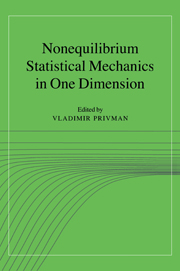Book contents
- Frontmatter
- Contents
- Contributors
- Preface
- Part I Reaction-Diffusion Systems and Models of Catalysis
- 1 Scaling theories of diffusion-controlled and ballistically controlled bimolecular reactions
- 2 The coalescence process, A + A → A, and the method of interparticle distribution functions
- 3 Critical phenomena at absorbing states
- Part II Kinetic Ising Models
- Part III Ordering, Coagulation, Phase Separation
- Part IV Random Adsorption and Relaxation Processes
- Part V Fluctuations in Particle and Surface Systems
- Part VI Diffusion and Transport in One Dimension
- Part VII Experimental Results
- Index
- Abbreviations
2 - The coalescence process, A + A → A, and the method of interparticle distribution functions
Published online by Cambridge University Press: 18 December 2009
- Frontmatter
- Contents
- Contributors
- Preface
- Part I Reaction-Diffusion Systems and Models of Catalysis
- 1 Scaling theories of diffusion-controlled and ballistically controlled bimolecular reactions
- 2 The coalescence process, A + A → A, and the method of interparticle distribution functions
- 3 Critical phenomena at absorbing states
- Part II Kinetic Ising Models
- Part III Ordering, Coagulation, Phase Separation
- Part IV Random Adsorption and Relaxation Processes
- Part V Fluctuations in Particle and Surface Systems
- Part VI Diffusion and Transport in One Dimension
- Part VII Experimental Results
- Index
- Abbreviations
Summary
The kinetics of the diffusion-limited coalescence process, A + A → A, can be solved exactly in several ways. In this chapter we focus on the particular technique of interparticle distribution functions (IPDFs), which enables the exact solution of some nontrivial generalizations of the basic coalescence process. These models display unexpectedly rich kinetic behavior, including instances of anomalous kinetics, self-ordering, and a dynamic phase transition. They also reveal interesting finite-size effects and shed light on the combined effects of internal and external fluctuations. An approximation based on the IPDF method is employed for analysis of the crossover between the reaction-controlled and diffusion-controlled regimes in coalescence when the reaction rate is finite.
Introduction
Reaction-diffusion systems are those in which the reactants are transported by diffusion. Two fundamental time scales characterize these systems: (a) the diffusion time—the typical time between collisions of reacting particles, and (b) the reaction time—the time that particles take to react when in proximity. When the reaction time is much larger than the diffusion time, the process is reaction-limited. In this case the law of mass action holds and the kinetics is well described by classical rate equations. In recent years there has been a surge of interest in the less tractable case of diffusion-limited processes, where the reaction time may be neglected.
- Type
- Chapter
- Information
- Nonequilibrium Statistical Mechanics in One Dimension , pp. 29 - 50Publisher: Cambridge University PressPrint publication year: 1997
- 6
- Cited by



